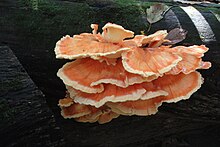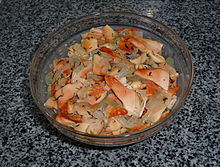Sulfur porlings
| Sulfur porlings | ||||||||||||
|---|---|---|---|---|---|---|---|---|---|---|---|---|

Common brimstone ( Laetiporus sulphureus ) in Belgium |
||||||||||||
| Systematics | ||||||||||||
|
||||||||||||
| Scientific name | ||||||||||||
| Laetiporus | ||||||||||||
| Murrill |
The sulfur porlings ( Laetiporus ) are a genus of fungi from the family of the stem porlings (Polyporaceae). The species can be found in many parts of the world. Some edible species, especially the common sulfur pork , are commonly known in English as "chicken of the woods" or "chicken mushroom" because the taste is often compared to chicken . Contrary to these trivial names , Laetiporus should not be confused with the edible common rattlesponge ( Grifola frondosa ), known in English as "hen of the woods", or the tufted rasling ( Lyophyllum decastes ), known as "fried chicken mushroom".
features
Individual specimens are between 5 and 25 cm wide. The consoles are made up of many fine tubular filaments ( hyphae ). The entire mycelium with its numerous thick lobes can weigh up to 45 kg. Representatives of the genus are often found on wounds of trees, through which they penetrate into the heartwood and decompose it. Typical hosts are oak , but also eucalyptus , yew , sweet chestnut , and willow , as well as some conifers such as Laetiporus coniferica , a species that is mainly found on red pines in the western parts of North America . Species of Laetiporus are distributed worldwide, a notable distribution area in Europe are riparian forests and moist mixed oak forests. Laetiporus can also be found on street trees in urban areas, and fruit trees can be affected in cultural landscapes. The hosts usually represent trees that are already more aged or otherwise damaged. The parasitic fungal growth by Laetiporus produces a visible brown rot in the host trees .
Young fruiting bodies are characterized by a moist, rubbery surface with a sulfur yellow to orange color, sometimes with bright orange tips. Older specimens fade and become brittle like chalk and are often of beetles , snails , or isopods eaten.
The common sulfur pore ( Laetiporus sulphureus ) sometimes forms fruiting bodies every year if the weather is suitable for sporulation. These thrive from late spring to early autumn, making it popular with mushroom pickers. At the same time, it represents a burden for the individual trees. After the heartwood has decomposed, the sapwood is often attacked, which in more advanced stages increases the brittleness and susceptibility to wind breakage and can lead to the collapse of the host tree, which can no longer bend in the wind.
Systematics

Below is a selection of known species that are assigned to the genus Laetiporus . 2 species occur in Europe or are to be expected there.
| Sulfur porlings ( Laetiporus ) worldwide |
Phylogenetics
On the basis of phylogenetic analyzes of the ITS separating DNA sequences, as well as the large subunit in the nuclear body and the mitochondrial small subunit of the rDNA of a selection of species in North America, five different clades within the common clade Laetiporus could be distinguished: A clade of species that live on conifers be found ( "Conifericola clade"), a clade the Laetiporus cincinnatus comprises two clades of Laetiporus sulphureus (sulphureus clade I comprises weißporige isolates, while sulphureus clade II gelbporige Laetiporussulphureus isolates comprises) as well as a clade the gilbertsonii Laetiporus and unidentified isolates Caribbean Origin includes ("Gilbertsonii clade").
Further phylogenetic clades were found in Japan , Hawaii , South America , Europe and South Africa , including the species Laetiporus cremeiporus , Laetiporus montanus and Laetiporus versisporus
edibility
Some types can be prepared similarly to chicken . As part of a vegan lifestyle, the mushroom can be used as a substitute for chicken. In addition, it can be frozen for longer periods of time to keep it edible. In some parts of Germany and North America, Laetiporus sulphureus in particular is a delicacy.
In some cases, consumption can cause mild reactions such as swollen lips in sensitive people or, in rare cases, nausea, vomiting, dizziness and disorientation. A number of factors are held responsible for this, from allergies to the protein of the mushrooms to toxins that are absorbed by the fungal tissue from the wood (for example from eucalyptus , cedar or yew ) or simply the consumption of specimens that have already decayed too much. For these reasons, many field guides urge caution towards those people who are thinking of eating Laetiporus , and only recommend eating specimens that have fresh, young fruiting bodies and initially only ingesting small amounts in order to assess the tolerance.
Laetiporus sulphureus can inhibit the growth of staphylococcus bacteria ( Staphylococcus aureus ) and, to a more moderate extent, the growth of Bacillus subtilis .
swell
literature
- Peter Schütt, Hans J. Schuck, Bernd Stimm: Lexicon of tree and shrub species . The standard work of forest botany. Morphology, pathology, ecology and systematics of important tree and shrub species. Nikol, Hamburg 2002, ISBN 978-3-933203-53-3 .
- German Josef Krieglsteiner (Ed.): The large mushrooms of Baden-Württemberg . Volume 1: General Part. Stand mushrooms: jelly, bark, prick and pore mushrooms. Ulmer, Stuttgart 2000, ISBN 3-8001-3528-0 .
- Heinrich Dörfelt , Gottfried Jetschke (Ed.): Dictionary of mycology. 2nd Edition. Spectrum Academic Publishing House, Heidelberg / Berlin 2001, ISBN 3-8274-0920-9 .
Individual evidence
- ^ British Mycological Society: English Names for fungi 2016 . Retrieved May 25, 2016.
- ↑ Harold H. Burdsall, Jr., Mark T. Banik: The genus Laetiporus in North America . In: Harvard Papers in Botany . 6, No. 1, 2001, pp. 43-55.
- ^ Index Fungorum: Names of fungi (including yeasts, lichens, chromistan fungal analogues, protozoan fungal analogues and fossil forms) at all ranks. . Retrieved May 31, 2016.
- ↑ Michal Tomsovský, Libor Jankovský: Validation and typification of Laetiporus montanus . In: Mycotaxon . tape 106 , 2008, p. 289-295 .
- ↑ Rimvydas Vasaitis, Audrius Menkis, Young Woon Lim, Soonja Seok, Michal Tomšovský, Libor Jankovský, Vaidotas Lygis, Bernard Slippers, Jan Stenlid: Genetic variation and relationships in Laetiporus sulphureus s. lat., as determined by ITS rDNA sequences and in vitro growth rate . In: Mycological Research . tape 113 , no. 3 , 2009, p. 326–336 ( PDF; 660 kB ).
- ↑ a b Mark T. Banik, Daniel L. Lindner, Yuko Ota, Tsutomu Hattori: Relationships among North American and Japanese Laetiporus isolates inferred from molecular phylogenetics and single-spore incompatibility reactions . In: Mycologia . tape 102 , no. 4 , 2010, p. 911–917 , doi : 10.3852 / 09-044 ( mycologia.org [PDF; 564 kB ]).
- ↑ Wolfgang Demon, Irmgard Krisai-Greilhuber: The database of Austria's mushrooms . In: Stapfia . tape 96 . Linz 2012, p. 245–330 ( PDF (7.3 MB) on ZOBODAT ).
- ^ Lindner DL, Banik MT: Molecular phylogeny of Laetiporus and other brown rot polypore genera in North America . In: Mycologia . 100, No. 3, 2008, pp. 417-30. doi : 10.3852 / 07-124R2 . PMID 18751549 .
- ↑ Michael W. Beug: Poisonous and hallucinogenic mushrooms . Retrieved May 31, 2016.
- ↑ Bruno Hennig, Hans Kreisel, Edmund Michael: The most important and most common mushrooms with special consideration of the toadstool . In: VEB Gustav Fischer (Ed.): Handbook for mushroom friends . 1, No. 5, Jena, 1983.
- ↑ Inmaculada Suay, Francisco Arenal, Francisco J. Asensio, Angela Basilio, M. Angeles Cabello, M. Teresa Díez, Juan B. García, Antonio González del Val, Julián Gorrochategui, Pilar Hernández, Fernando Peláez, M. Francisca Vicente: Screening of basidiomycetes for antimicrobial activities . In: Antonie Van Leeuwenhoek . 78, No. 2, Aug 2000, pp. 129-39. doi : 10.1023 / A: 1026552024021 . PMID 11204765 .





